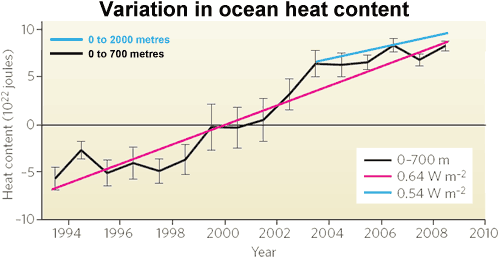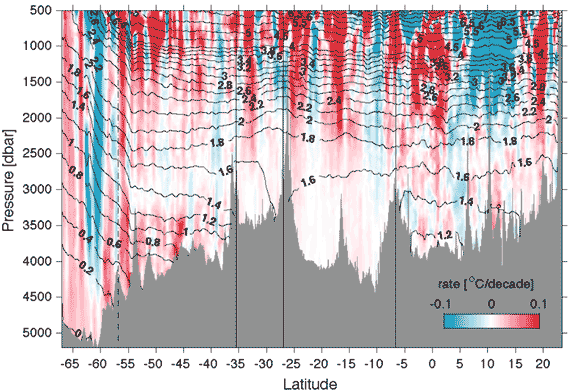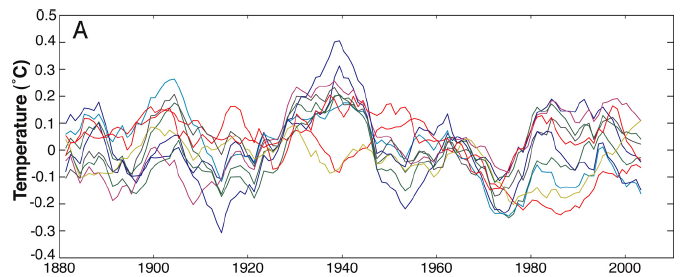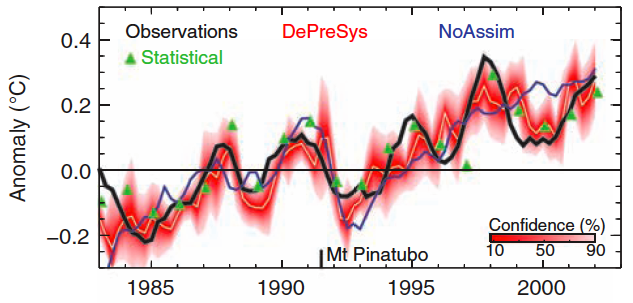Lindzen Illusion #5: Internal Variability
Posted on 8 May 2011 by dana1981
 In a recent media article which was uncritically re-posted at a number of websites like "skeptic" blog WattsUpWithThat, in amongst many other erroneous statements, Richard Lindzen attempted to blame global warming on natural internal variability (emphasis added):
In a recent media article which was uncritically re-posted at a number of websites like "skeptic" blog WattsUpWithThat, in amongst many other erroneous statements, Richard Lindzen attempted to blame global warming on natural internal variability (emphasis added):
"For small changes in climate associated with tenths of a degree, there is no need for any external cause. The earth is never exactly in equilibrium. The motions of the massive oceans where heat is moved between deep layers and the surface provides variability on time scales from years to centuries."
Achilles Heel for Internal Variability
In the quote above, Lindzen has unwittingly revealed the Achilles heel of the 'internal variability' argument. Internal variability means that heat is just being moved around from one part of the Earth's climate system from another, i.e. in Lindzen's example, from the deep ocean layers to the surface. But if the movement of heat from the deep oceans is what's causing the surface air to warm, this hypothesis requires that the oceans as a whole and deep ocean layers in particular must be cooling.
In reality, that's not happening. We know that the upper 2,000 meters of the oceans exhibit a long-term accumulation of heat (Figure 1).

Figure 1: Changing heat content of the global ocean, with respect to the mean of 1993 to 2008 (Trenberth 2010). This analysis samples the ocean to 700 m depth and gives an average warming trend of 0.64 W m−2 (pink line). The data available from Argo floats since 2003 enable an estimate to 2,000 m depth (blue line).
And Purkey & Johnson (2010) reconstructed ocean heat accumulation down to abyssal depths and found significant amounts of heat building up even at the bottom of the ocean (Figure 2).

Figure 2: Rate of ocean warming. Areas of warming are shaded in red and regions of cooling are shaded in blue with intensity scaled by the magnitude of the warming. The basins from south to north are the Southeast Pacific Basin, Chile Basin, Peru Basin, and Pacific Basin (Purkey & Johnson 2010).
There are several other indicators of building ocean heat. Satellites observing incoming and outgoing radiation are able to measure changes in the planet's energy imbalance from year to year. What they find is the planet's energy imbalance continues to increase (Trenberth & Fasullo 2010, Hansen et al. 2011). And sea levels continue to rise, largely due to thermal expansion as a result of the warming oceans.
Clearly this warming of the entire global climate system must be caused by an external forcing, and the radiative forcings over the past century have been dominated by greenhouse gases. Lindzen's internal variability argument just doesn't hold up in the face of the observational data and physical reality. Unfortunately, in the aforementioned article, Lindzen proceeds to attempt to defend this indefensible argument by misrepresenting the work of a number of other climate scientists.
Tsonis et al. 2007
Lindzen first makes the following claim about the work of Tsonis and colleagues:
"Recent work (Tsonis et al, 2007), suggests that this variability is enough to account for all climate change since the 19th Century."
This statement is quite different from the actual conclusions of Tsonis et al. (2007) (emphasis added):
"The standard explanation for the post 1970s warming is that the radiative effect of greenhouse gases overcame shortwave reflection effects due to aerosols [Mann and Emanuel, 2006]. However, comparison of the 2035 event in the 21st century simulation and the 1910s event in the observations with this event, suggests an alternative hypothesis, namely that the climate shifted after the 1970s event to a different state of a warmer climate, which may be superimposed on an anthropogenic warming trend."
Nowhere in their paper do Tsonis et al. claim that natural variability can account for the entire warming trend over the past century. Tsonis was also a co-author on a more recent paper, Swanson et al. (2009) which John has previously discussed.
Swanson and Tsonis 2009 was a similar study exploring the role of natural variability in global temperatures, and as with Lindzen's treatment of Tsonis' 2007 paper, it was widely misrepresented, as Dr. Swanson noted:
"What do our results have to do with Global Warming, i.e., the century-scale response to greenhouse gas emissions? VERY LITTLE, contrary to claims that others have made on our behalf. Nature (with hopefully some constructive input from humans) will decide the global warming question based upon climate sensitivity, net radiative forcing, and oceanic storage of heat, not on the type of multi-decadal time scale variability we are discussing here. However, this apparent impulsive behavior explicitly highlights the fact that humanity is poking a complex, nonlinear system with GHG forcing – and that there are no guarantees to how the climate may respond."
In their paper, Swanson and Tsonis use climate models to hash out the role internal variability has played in average global temperature changes over the past century (Figure 3).

Figure 3: Estimation of the observed signature of internal variability in the observed 20th century global mean temperature in climate model simulations
As you can see, over periods of a few decades, modeled internal variability does not cause surface temperatures to change by more than 0.3°C, and over the entire 20th Century, its transient warming and cooling influences tend to average out, and internal variability does not cause a long-term temperature trend.
Smith et al. 2007
Lindzen's article proceeds with an even worse misrepresentation of Smith et al. 2007 (emphasis added):
"scientists at the UK’s Hadley Centre for Climate Research recently noted that their model did not appropriately deal with natural internal variability thus demolishing the basis for the IPCC’s iconic attribution (Smith et al, 2007). Interestingly (though not unexpectedly), the British paper did not stress this. Rather, they speculated that natural internal variability might step aside in 2009, allowing warming to resume."
So according to Lindzen, Smith et al. (2007) "demolishes the basis" for attributing global warming over the past century to anthropogenic influences. I'm sure this interpretation of their work would come as a shock to the authors, who conclude as follows:
"We present a new modeling system that predicts both internal variability and externally forced changes and hence forecasts surface temperature with substantially improved skill throughout a decade, both globally and in many regions. Our system predicts that internal variability will partially offset the anthropogenic global warming signal for the next few years....Both NoAssim and DePreSys, however, predict further warming during the coming decade, with the year 2014 predicted to be 0.30° ± 0.21°C [5 to 95% confidence interval (CI)] warmer than the observed value for 2004. Furthermore, at least half of the years after 2009 are predicted to be warmer than 1998, the warmest year currently on record."
DePreSys is a dynamical climate model which takes into account the observed state of the atmosphere and ocean in order to predict internal variability, while NoAssim is identical to DePreSys, but does not assimilate the observed state of the atmosphere or ocean or predict internal variability. Smith et al. used these models to compare the accuracy of the model global temperature hindcasts back to 1982 (Figure 4).

Figure 4: Smith et al. (2007) temperature hindcasts for the DePreSys model (red, accounting for internal variability) and NoAssim (blue, no internal variability)
As you can see, the DePreSys model (which accounts for internal variability) matches the short-term temperature changes significantly better than the NoAssim model. However, both models produce the same warming trend. So how does Lindzen conclude that this paper "demolishes the basis" for man-made global warming when accounting for natural variability does not change the warming trend? Your guess is as good as mine, but it's clearly a gross misrepresentation of the results of the study.
Wrong for Two Decades, Again
As with many of Lindzen's arguments, he's been making this one for a long time. In his 1989 MIT Tech Talk, Lindzen similarly argued that global warming boiled down to little more than internal variability.
"What we have is data that says that maybe [warming] occurs, but it's within the noise....The point we have to keep in mind is that without any of this at all our climate would wander--at least within limits."
However, as we've shown in this post, contrary to Lindzen's claims, internal variability simply cannot account for the warming over the past century. The magnitude of the observed warming is too large, and the fact that the entire climate system is warming tells us that an external forcing is at work. Perhaps most disturbing is Lindzen's misrepresentation of other climate scientists' work in defending his fundamentally flawed argument.
Bottom line, as convenient as it would be, it's not internal variability!































 Arguments
Arguments






























[DB] Hot-linked URL.